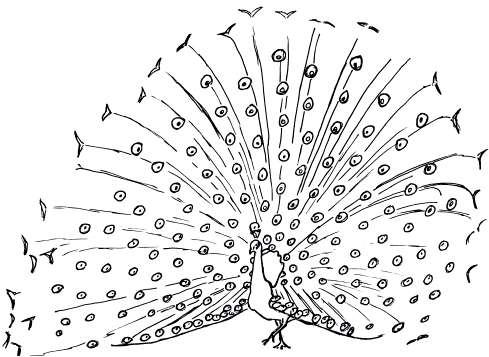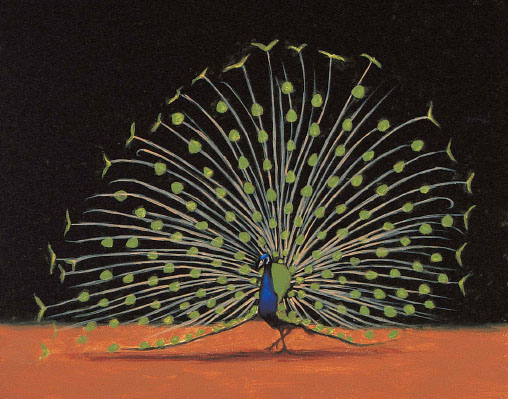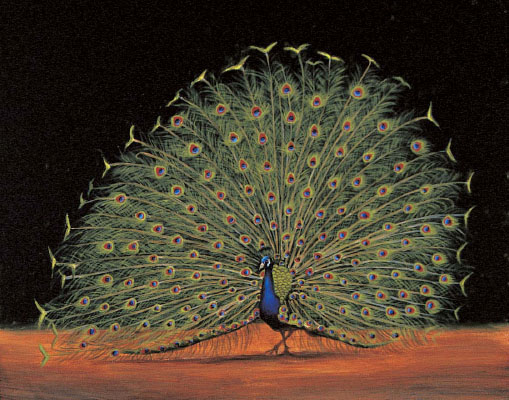Project 48: Peacock
The Indian Blue peacock has brilliant, iridescent blue-green plumage. The tail, also called the train, has a series of feathers called eyes, which are seen when the tail is fanned. This magnificent peacock lives at the Primate Rescue Center in Jessamine County, Kentucky. The peafowl roam freely around outdoor enclosures for monkeys and apes.


Reference Photo
Materials
Paints
Burnt Umber
Cadmium Orange
Hansa Yellow Light
Hooker’s Green Permanent
Naples Yellow
Raw Sienna
Red Oxide
Titanium White
Ultramarine Blue
Brushes
no. 3 and 10 rounds
no. 6 and 12 brights

1 Establish the Form
Lightly sketch the peacock onto the panel in pencil, using a kneaded eraser for corrections or to lighten lines. With diluted Burnt Umber and a no. 10 round, paint the main lines of the peacock.

2 Paint the Background and Body Colors
Mix warm black with Ultramarine Blue and Burnt Umber. Paint the dark shadows on the bird’s body and the dark lines on the underside of the tail with a no. 10 round. Mix bright blue for the bird’s body with Ultramarine Blue and Titanium White. Paint with a no. 3 round, blending with the shadowed areas.
Mix dark green for the background with Hooker’s Green Permanent, Burnt Umber and Ultramarine Blue. Paint dabbing strokes with a no. 12 bright, switching to a no. 6 bright to paint around the feather patterns. Use a no. 10 round to paint around the peacock’s body. After the first layer of dark green has dried, strengthen it with a second coat.

3 Paint the Foreground and Feather Patterns
Mix a dark brown for the bird’s lower body, legs and feet with Burnt Umber, Ultramarine Blue and Raw Sienna. Paint with a no. 3 round.
Make a shadow color for the bird’s shadow on the ground with Burnt Umber and Raw Sienna. Paint horizontal strokes with a no. 10 round.
Create a golden tan for the ground with Titanium White, Raw Sienna and Naples Yellow. Paint smooth, horizontal strokes with a no. 12 bright; switch to a no. 6 bright to paint around the bird. Blend where the shadow and dark green meet the golden tan, using separate no. 6 rounds for each color.
Paint the dark line at the underside of the tail with dark green and a no. 10 round. Mix Hooker’s Green Permanent, Hansa Yellow Light, Cadmium Orange and Titanium White to create light green for the mass of feathers behind the neck. Paint with a no. 10 round. With the same color and a no. 3 round, paint the feather eyes.
Re-establish the legs and feet with dark brown and a no. 3 round. Darken the bird’s shadow on the ground with a few horizontal strokes of dark brown.
Make a light tan for the feather shafts with a portion of golden tan and Titanium White. Paint the shafts with a no. 3 round, using long, thin, slightly curving strokes; use just enough water to make the paint flow. Use the same color to paint the beak. More than one coat is needed for good coverage. Make any corrections, such as shafts that come out too thick or uneven, with dark green.
Mix a highlight color for the bird’s body with some bright blue and Titanium White. Paint with a no. 3 round, blending with the adjacent color. Re-establish the white marking on the head with Titanium White. Add a tiny dot of Titanium White to the eye for the highlight.

4 Add Feather Detail and Modify the Foreground
Darken the golden tan foreground with a glaze of diluted Burnt Umber. Paint horizontal strokes with a no. 12 bright. When dry, create shadows at the lower part of the foreground and darken the bird’s shadow on the ground with a glaze of Ultramarine Blue and water.
Make a brick red color for the feather eyes with Red Oxide, Titanium White and Naples Yellow. Paint the inside of the feather eyes with a no. 3 round, leaving a border of green. Re-establish the green borders as needed.
Create medium blue for the feather eyes with Ultramarine Blue and Titanium White. Paint small spots inside the brick red areas at the lower part of the feather eyes with a no. 3 round.
With dark green and a no. 3 round, sharpen and define the V-shaped feathers at the edges of the tail.

5 Paint More Feather Detail
With a glaze of diluted dark green, use a no. 10 round to slightly darken the feather shafts. Using light green and a no. 3 round, paint a fringe from the tip of each feather eye with small strokes. Use the same color and brush and a small amount of paint to create the feather patterns from each shaft with thin, parallel strokes. The overlapping lines will create a crisscross pattern.
With a no. 3 round, paint a thin glaze of Hansa Yellow Light and water over the mass of feathers behind the neck. Reinforce the dark lines on the underside of the tail with a no. 3 round and dark green. Make medium green with some dark green, light green and Hansa Yellow Light. Paint along the underside of the tail with a no. 3 round, blending where it meets the dark green with a separate brush and dark green.
Paint the feather detail for the feathers overlapping the golden tan with dark green and a no. 3 round, toning down as needed with light green. Paint a thin fringe of feathers hanging down from the underside of the tail with dark green and a no. 3 round, using a small amount of diluted paint.

FAN DANCER
Acrylic on Gessobord
8” × 10” (20cm × 25cm)
6 Paint the Finishing Details
Use bright blue and a no. 3 round to paint the rounded dark spots on the feather eyes. When dry, reinforce as needed with a second coat. Paint the crest of feathers above the head with bright blue.
Use light green to paint fringes from any of the feather eyes you may have missed in the previous step.
